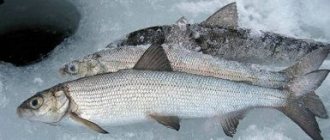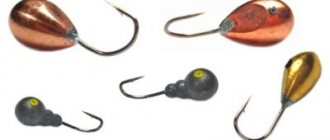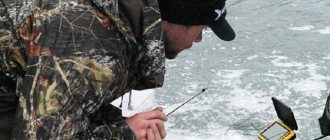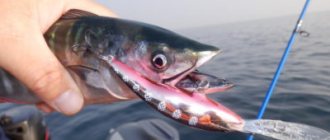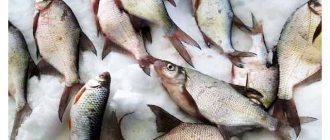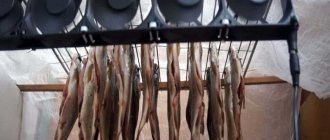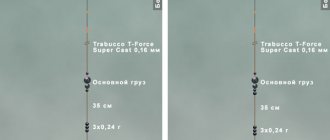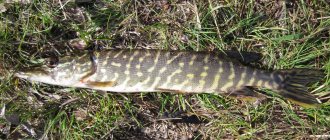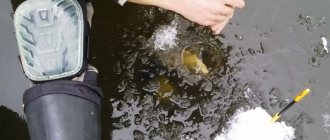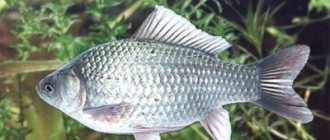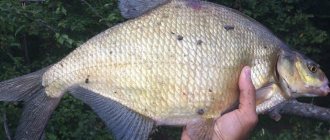Methods for catching ide from ice
One of the most effective ways of catching ide in winter is fishing with a jig. When catching this fish in this way, you must follow some rules. When biting, the ide often swallows the bait along with the hook, so it should be hooked after some time (2-3 seconds). When fishing for an ide, you should not loosen the line; you need to let the fish become exhausted, and then smoothly lift the ide to the surface.
Read! Tackle garland for winter fishing
The color of the jig should depend on weather conditions. So, when catching this fish in clear, sunny weather, tackle of copper and brass colors is best suited, and on cloudy days - silver-colored jigs.
When catching ide with a jig, you should make smooth oscillations of the bait at the bottom, periodically raising and lowering the tackle.
When fishing for ide using a trolling method, the fish bite is clearly felt, so instead of a nod, it is best to take a hard whip. The thickness of the fishing line should be taken in the range from 0.14 to 0.22 mm, depending on the size of the intended prey.
Small vertical spoons, the color of which depends on the depth, are used as bait. Bronze and copper-colored tackle are best used in the shallows, while polished spoons work well in deeper areas. In order for the spoon to imitate the movement of live fish as much as possible, it must first be smoothly lifted from the bottom and then sharply lowered. When the spoon sinks to the bottom, you need to make several pendulum movements.
In winter, catching ide on a balancer gives good results. The technique of fishing with this tackle is almost the same as the technique of fishing with a spinner.
What to catch ide in winter
Natural baits for catching ide in winter . Since in winter ide is usually just an addition to catching perch or bream, many baits are used that are suitable for other types of fish. To catch ide in winter, it is best to use baits of animal origin, although ide can be caught well on dough in winter. It's better to use:
- bloodworm;
- maggot;
- worm;
- burdock moth larva;
- bark beetle
Ide can also be caught using live bait, but it is very difficult to catch a roach using live bait. Therefore, live bait is more often used when fishing for ide in winter on large rivers, where this fish reaches a respectable size. On small bodies of water it is better to use more modest bait.
You should know that ide will never bite on ruff, perch or goby. The best live bait for catching ide in winter is crucian carp, rudd, perch, bitterling, and roach.
Typically, ide is caught at a higher level than other fish, so purposeful fishing for ide usually involves abandoning other fish. When fishing from the bottom, you essentially lose the opportunity to catch an ide, and when fishing in the middle layers, there will be no bites from other fish, which usually stand at the bottom. Artificial bait for ide in winter . To catch ide in winter, you can successfully use both jigs and winter spinners. In winter, ide is caught using the following baits:
- perch spoon;
- reelless jig;
- jig;
- balance.
I’ll say right away that a balancer is the most unlucky option for catching ide in winter. It is extremely rare to catch ide on this bait, although perhaps on some models of balancers the ide bite will be quite good. Ide is caught very well with small spoons, approximately the same as those used for catching perch. The spoon should be no less than 3 cm long and up to 1 cm wide. The ide has a small mouth, so it is important not to overdo it with the size of the bait. The ide also works well on a jig, but it is best to use a jig with bloodworms or maggots. In order to increase the attention of the ide to your jig, you can hang a small colored cambric or even several different colors on it. Such a play of colors can attract the attention of an ide better than an ordinary jig. You can use jigs of any shape and experiment. But the following jigs reliably show good results:
- Uralka;
- ant;
- devil.
If the ide doesn't bite . Since winter fishing is often unpredictable, the ide may refuse to bite at all. To activate its bite you need to use bait. A regular feed maggot is suitable for this. It is necessary to feed very little, literally half a meal, so as not to overfeed the fish, which in winter feeds much less and gorges on even a small amount of food. It is best to mix breadcrumbs with the bloodworms, then the effect of the bait will increase significantly. So, by adding a little bait into the hole, you can keep the fish at the fishing point and stabilize the bite.
Groundbait, baits and lures
Ice fishing for ide will be much more successful if you use bait. Usually, winter bait for ide consists of various plant components, but it is recommended to add protein components to winter bait. It is better if these are special protein supplements intended for fish from the carp family. Therefore, experienced fishermen advise using bait. To lure the ide to the right place. This bait is usually prepared from crushed bloodworms, which are placed in a piece of cloth and then lowered into the hole. The smell of such bait, which quickly spreads with the current, can attract fish that are located at a relatively large distance from the fishing site.
It is known that ide is not too picky about food and feeds on both plant foods and foods of animal origin. In winter, ide is caught more using animal baits, maggots, burdock larva, bloodworms, and bark beetle larva. However, in the absence of a bite, a sandwich is often a good incentive for its bite. This can be a combination of animal baits, such as bloodworms and maggots, or animal and vegetable baits, such as sweetened dough and bark beetle larva. That is, in the absence of a bite, you should not leave a promising place, but try to combine baits and attachments.
In large rivers, ide is caught in deep river-bed holes for fry. First of all, these are bleak, roach, verkhovka, mustard, and crucian carp. As for such fish as perch, ruff, or goby, then such fry will definitely not take ide. Small ide (roach), as a rule, is caught mainly with bloodworms. Most often, roaches are caught during targeted fishing for perch or roach. The thing is that both roach and perch are closer to the bottom, while ide prefers the middle layers of water. And if you set the tackle to catch small ide, then both roach and perch are cut off.
Of the baits used for catching ide from ice, jigs are most often used, often homemade. Although large ide are often caught by trolling, using light-colored spoons. The size of such baits should not be larger than the spinners that are used for catching perch, but they should be slightly more powerful than perch baits. The thickness of such bait should not exceed 2.5-3 mm. In the process of ice fishing for ide, the same game is used as for catching perch.
How to feed an ide
As already mentioned, on the Volga and other large rivers, ides prefer to stay in a moderate current not far from the fairway. Here, along with ide, bream, silver bream, and blue trout are common prey. For better results, it is better to use long-term bait - bait. Then the ide will remain under the attached holes almost constantly, at least until a sudden change in weather. You can attach them using bait balls, slightly flattened so that they are not pulled off by the current. But this is on a weak current. In moderate and relatively strong currents in places attractive for ide, and these are uneven bottoms and snags, it is better to lower a stationary feeder to the bottom, the same conical metal one, which is also called a “dump truck”, since you can dump bait from it at the bottom or near the bottom when using a pulled pin that holds the bottom of the feeder. But here the moving element of the dump truck just needs to be fixed and the feeder will become stationary. As the bait is washed out, you will need to add a winter universal or special mixture for ide from Dunaev, Greenfishing, Sensas with a proprietary filler or filler from “Salapin porridge” to the feeder. You should not add bright or fruity flavors to this ide mixture. Syrups with the scent of salmon, fish in hemp, and crayfish are better suited for winter. The bait is: bloodworms, worms, maggots. Closer to spring and spring, ide can also appear on bread, especially on the crust of wheat or rye bread.
We fish in winter. Beyond the river
Yazi can be active at different times of the year, so winter is not a hindrance for him. The main thing is to know when you can catch it, where and with what. We'll tell you how you can catch ides in rivers in winter.
The most favorable time for fishing ides in winter is considered to be the beginning of winter, according to the first ice, and the end of the winter season, according to the last ice. Fishing is also good during thaws. But in severe frosts, ide, on the contrary, is not caught because it lies on the bottom. But, with the onset of a thaw, fish quite often come out to shallow sections of rivers. Usually it stands at depths of 5-2 meters, near riffles, trees or lowlands fallen into the water. From such places she periodically comes out to look for food near the river currents.
If the oxygen regime in the reservoir is at a good level, the water is constantly enriched with oxygen from streams, springs, springs or small rivers, then ides come out to look for food at their mouths not only in the spring season, but also in the middle of winter. This especially happens with the onset of warm days with low atmospheric pressure. We caught ides on favorable days and in snags where perches are usually found. If we talk about the depths of fishing, then ides can be unpredictable. And this fact applies not only in summer, but also in winter. They search for fish by fishing all horizons of the water column, and the trophy can be bitten either at the bottom or in middle waters, as well as at the very surface under the ice.
Read: Catching large roach with a baitless jig
The best times of day for catching ide are considered to be evening, morning and night. They fish on a winter fishing rod with a jig, placing a piece of fish, small worms, maggots or bloodworms on its hook. Medium black jigs with bright splashes are considered the optimal catchable baits. Some anglers also catch ide with light-colored perch spinners. Other anglers have adapted to fishing with live bait using poles. In this gear, it is best to use minnows or bleak as live bait.
It is best to use bait at the end or beginning of winter. At this time, it can bring good results. It is easy to prepare, for which bloodworms and egg whites are added to the base of plant ingredients. The tactics for using such bait are simple. Having caught a random ide, a little bait is thrown into the hole. After some time, a flock of his relatives should run to this place.
After the fish bites, you must make a hook, and it should be done carefully, just like when you fish out an ide. Knowing that fish are less active on the hook in winter, there is no need to relax. After hooking, yazzies can make quite strong maneuvers and jerks, for which you need to be prepared. But the fish does not resist for a long time, as it gets tired, which the fisherman must quickly take advantage of and pull the trophy onto the ice.
Read: Subtleties of fishing on the bulldozer
Ise are often caught together with other fish that are nearby. This can be either roach or perch, and you can also focus on the bite of dace, which, together with ide, lead a similar lifestyle in winter. Happy ide fishing!
Fishing gear
Since ide is caught in the current, fairly massive tungsten jigs are needed. A tandem of jigs often wins in terms of performance, where a heavy black jig made of tungsten is located below, and a small silver or green jig also made of tungsten is tied 12-14 cm above. The fishing line used is not the thinnest. Usually this is a monofilament line with a diameter of 0.14-0.18 mm. Ide is a strong fish. The nods are used hard, especially for the current, about 15 cm long. The fishing technique is similar to the technique of catching bream. The same smooth ascents and descents of the jig to the bottom with swarming in the bottom silt. Often ide bites occur in the upper water levels. To catch active ide, you can change the smooth action of jigs to a faster and more aggressive one.
Often the largest ides are caught on reelless jigs, for example, on a nail ball with a green luminous bead, if fishing occurs at depth. Also successful are “goat cat’s eye” jigs with a green bead and devils with a black body with a red bead above the tee. This is where active play comes into play.
Yazi and bream Sabanakovo
Fishing for tench from ice
How I picked up the key to the asp
Where to look for ide in winter
Success in ice fishing is largely determined by knowledge of the topography of the bottom of the reservoir. It is very useful to study the water area in the summer, then it will be easier to find promising areas for fishing. In this case, you won’t have to make many holes to find interesting edges, snags, riffles, etc. Ide is often caught along with such types of fish as bream, roach and perch. Large individuals love deep holes. However, often not only the bottom layer is occupied by fish, but also higher horizons. The ide does not stand in a strong current; it is more convenient for it to be placed behind obstacles at the bottom. In winter, only small roaches can live in flocks, but trophy specimens prefer to live alone. When harsh weather brings warm days, ide rushes to the shallows. Here large fish can find easy food in the form of fry. At such moments, you should make holes in shallow water, at the mouths of small streams and rivulets. The fishing depth may not exceed 0.5 m. Sometimes perch or pike hunters with a spoon become the owners of trophy ides caught near the shore. This behavior of the fish can only be explained by feeding with fry. Winter resting places for ide can be dumps, exits from pits, and natural shelters in the form of snags or stones. At such points you should look for this handsome red-finned fish during the entire freeze-up period.
— Accounting for the time of year
Both the choice of fishing gear and jig fishing by fishermen depend on the time of year. During the period of first ice, the fish are still quite energetic due to the presence of a large amount of oxygen in the water. So you should move the jig actively, with a large amplitude.
In the dead of winter, life under the ice freezes. To awaken interest, you need to “shake” the bait two to three times per second. And vertical movements are significantly shortened.
When the fish begins to “wake up”, fishing becomes more active. Searching for food makes the fish move faster, so the amplitude of oscillations must be increased, reducing the number of oscillations.
